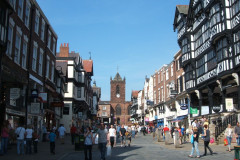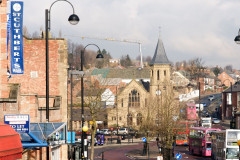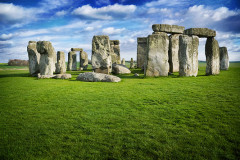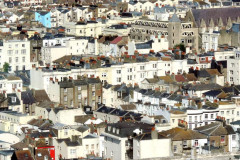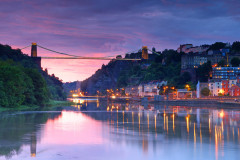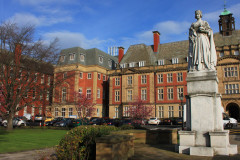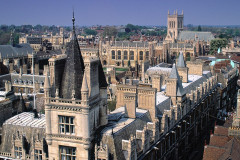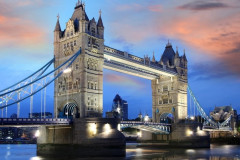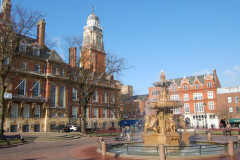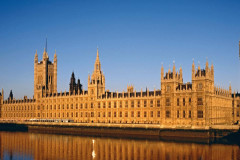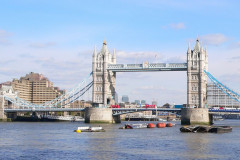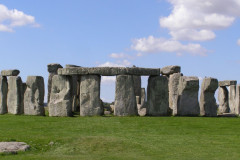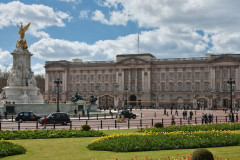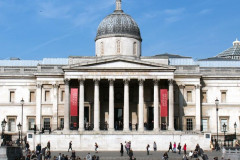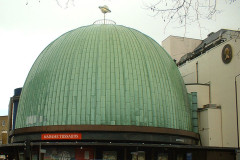England
Description
England is a country that is part of the United Kingdom. It shares land borders with Scotland to the north and Wales to the west. The Irish Sea lies northwest of England and the Celtic Sea lies to the southwest. England is separated from continental Europe by the North Sea to the east and the English Channel to the south. The country covers much of the central and southern part of the island of Great Britain, which lies in the North Atlantic; and includes over 100 smaller islands such as the Isles of Scilly, and the Isle of Wight.
The area now called England was first inhabited by modern humans during the Upper Palaeolithic period, but takes its name from the Angles, one of the Germanic tribes who settled during the 5th and 6th centuries. England became a unified state in the 10th century, and since the Age of Discovery, which began during the 15th century, has had a significant cultural and legal impact on the wider world. The English language, the Anglican Church, and English law – the basis for the common law legal systems of many other countries around the world – developed in England, and the country's parliamentary system of government has been widely adopted by other nations. The Industrial Revolution began in 18th-century England, transforming its society into the world's first industrialised nation.
England's terrain mostly comprises low hills and plains, especially in central and southern England. However, there are uplands in the north (for example, the mountainous Lake District, and the Pennines) and in the south west (for example, Dartmoor and the Cotswolds). The capital is London, which is the largest metropolitan area in both the United Kingdom and the European Union. England's population of over 53 million comprises 84% of the population of the United Kingdom, largely concentrated around London, the South East, and conurbations in the Midlands, the North West, the North East, and Yorkshire, which each developed as major industrial regions during the 19th century.
The Kingdom of England—which after 1535 included Wales—ceased being a separate sovereign state on 1 May 1707, when the Acts of Union put into effect the terms agreed in the Treaty of Union the previous year, resulting in a political union with the Kingdom of Scotland to create the Kingdom of Great Britain. In 1801, Great Britain was united with the Kingdom of Ireland through another Act of Union to become the United Kingdom of Great Britain and Ireland. In 1922 the Irish Free State seceded from the United Kingdom, leading to the latter being renamed the United Kingdom of Great Britain and Northern Ireland.
Toponymy
The name "England" is derived from the Old English name Englaland, which means "land of the Angles". The Angles were one of the Germanic tribes that settled in Great Britain during the Early Middle Ages. The Angles came from the Angeln peninsula in the Bay of Kiel area of the Baltic Sea. The earliest recorded use of the term, as "Engla londe", is in the late ninth century translation into Old English of Bede's Ecclesiastical History of the English People. The term was then used in a different sense to the modern one, meaning "the land inhabited by the English", and it included English people in what is now south-east Scotland but was then part of the English kingdom of Northumbria. The Anglo-Saxon Chronicle recorded that the Domesday Book of 1086 covered the whole of England, meaning the English kingdom, but a few years later the Chronicle stated that King Malcolm III went "out of Scotlande into Lothian in Englaland", thus using it in the more ancient sense. According to the Oxford English Dictionary, its modern spelling was first used in 1538.
The earliest attested reference to the Angles occurs in the 1st-century work by Tacitus, Germania, in which the Latin word Anglii is used. The etymology of the tribal name itself is disputed by scholars; it has been suggested that it derives from the shape of the Angeln peninsula, an angular shape. How and why a term derived from the name of a tribe that was less significant than others, such as the Saxons, came to be used for the entire country and its people is not known, but it seems this is related to the custom of calling the Germanic people in Britain Angli Saxones or English Saxons. In Scottish Gaelic, another language which developed on the island of Great Britain, the Saxon tribe gave their name to the word for England (Sasunn); similarly, the Welsh name for the English language is "Saesneg".
An alternative name for England is Albion. The name Albion originally referred to the entire island of Great Britain. The nominally earliest record of the name appears in the Aristotelian Corpus, specifically the 4th century BC De Mundo: "Beyond the Pillars of Hercules is the ocean that flows round the earth. In it are two very large islands called Britannia; these are Albion and Ierne". But modern scholarly consensus ascribes De Mundo not to Aristotle but to Pseudo-Aristotle, i.e. it was written later in the Graeco-Roman period or afterwards. The word Albion (Ἀλβίων) or insula Albionum has two possible origins. It either derives from a cognate of the Latin albus meaning white, a reference to the white cliffs of Dover, the only part of Britain visible from the European Continent, or from the phrase the "island of the Albiones" in the now lost Massaliote Periplus, that is attested through Avienus' Ora Maritima to which the former presumably served as a source. Albion is now applied to England in a more poetic capacity. Another romantic name for England is Loegria, related to the Welsh word for England, Lloegr, and made popular by its use in Arthurian legend.
History
Prehistory and antiquity
The earliest known evidence of human presence in the area now known as England was that of Homo antecessor, dating to approximately 780,000 years ago. The oldest proto-human bones discovered in England date from 500,000 years ago. Modern humans are known to have inhabited the area during the Upper Paleolithic period, though permanent settlements were only established within the last 6,000 years. After the last ice age only large mammals such as mammoths, bison and woolly rhinoceros remained. Roughly 11,000 years ago, when the ice sheets began to recede, humans repopulated the area; genetic research suggests they came from the northern part of the Iberian Peninsula. The sea level was lower than now and Britain was connected by land bridge to Ireland and Eurasia. As the seas rose, it was separated from Ireland 10,000 years ago and from Eurasia two millennia later.
The Beaker culture arrived around 2,500 BC, introducing drinking and food vessels constructed from clay, as well as vessels used as reduction pots to smelt copper ores. It was during this time that major Neolithic monuments such as Stonehenge and Avebury were constructed. By heating together tin and copper, which were in abundance in the area, the Beaker culture people made bronze, and later iron from iron ores. The development of iron smelting allowed the construction of better ploughs, advancing agriculture (for instance, with Celtic fields), as well as the production of more effective weapons.
During the Iron Age, Celtic culture, deriving from the Hallstatt and La Tène cultures, arrived from Central Europe. Brythonic was the spoken language during this time. Society was tribal; according to Ptolemy's Geographia there were around 20 tribes in the area. Earlier divisions are unknown because the Britons were not literate. Like other regions on the edge of the Empire, Britain had long enjoyed trading links with the Romans. Julius Caesar of the Roman Republic attempted to invade twice in 55 BC; although largely unsuccessful, he managed to set up a client king from the Trinovantes.
The Romans invaded Britain in 43 AD during the reign of Emperor Claudius, subsequently conquering much of Britain, and the area was incorporated into the Roman Empire as Britannia province. The best-known of the native tribes who attempted to resist were the Catuvellauni led by Caratacus. Later, an uprising led by Boudica, Queen of the Iceni, ended with Boudica's suicide following her defeat at the Battle of Watling Street. This era saw a Greco-Roman culture prevail with the introduction of Roman law, Roman architecture, aqueducts, sewers, many agricultural items and silk. In the 3rd century, Emperor Septimius Severus died at Eboracum (now York), where Constantine was subsequently proclaimed emperor.
There is debate about when Christianity was first introduced; it was no later than the 4th century, probably much earlier. According to Bede, missionaries were sent from Rome by Eleutherius at the request of the chieftain Lucius of Britain in 180 AD, to settle differences as to Eastern and Western ceremonials, which were disturbing the church. There are traditions linked to Glastonbury claiming an introduction through Joseph of Arimathea, while others claim through Lucius of Britain. By 410, during the Decline of the Roman Empire, Britain was left exposed by the end of Roman rule in Britain and the withdrawal of Roman army units, to defend the frontiers in continental Europe and partake in civil wars. Celtic Christian monastic and missionary movements flourished: Patrick (5th-century Ireland) and in the 6th century Brendan (Clonfert), Comgall (Bangor), David (Wales), Aiden (Lindisfarne) and Columba (Iona). This period of Christianity was influenced by ancient Celtic culture in its sensibilities, polity, practices and theology. Local "congregations" were centred in the monastic community and monastic leaders were more like chieftains, as peers, rather than in the more hierarchical system of the Roman-dominated church.
Middle Ages
Roman military withdrawals left Britain open to invasion by pagan, seafaring warriors from north-western continental Europe, chiefly the Angles, Saxons and Jutes who had long raided the coasts of the Roman province and began to settle, initially in the eastern part of the country. Their advance was contained for some decades after the Britons' victory at the Battle of Mount Badon, but subsequently resumed, over-running the fertile lowlands of Britain and reducing the area under Brythonic control to a series of separate enclaves in the more rugged country to the west by the end of the 6th century. Contemporary texts describing this period are extremely scarce, giving rise to its description as a Dark Age. The nature and progression of the Anglo-Saxon settlement of Britain is consequently subject to considerable disagreement. Roman-dominated Christianity had in general disappeared from the conquered territories, but was reintroduced by missionaries from Rome led by Augustine from 597 onwards. Disputes between the Roman- and Celtic-dominated forms of Christianity ended in victory for the Roman tradition at the Council of Whitby (664), which was ostensibly about haircuts and the date of Easter, but more significantly, about the differences in Roman and Celtic forms of authority, theology, and practice (Lehane).
During the settlement period the lands ruled by the incomers seem to have been fragmented into numerous tribal territories, but by the 7th century, when substantial evidence of the situation again becomes available, these had coalesced into roughly a dozen kingdoms including Northumbria, Mercia, Wessex, East Anglia, Essex, Kent and Sussex. Over the following centuries this process of political consolidation continued. The 7th century saw a struggle for hegemony between Northumbria and Mercia, which in the 8th century gave way to Mercian preeminence. In the early 9th century Mercia was displaced as the foremost kingdom by Wessex. Later in that century escalating attacks by the Danes culminated in the conquest of the north and east of England, overthrowing the kingdoms of Northumbria, Mercia and East Anglia. Wessex under Alfred the Great was left as the only surviving English kingdom, and under his successors it steadily expanded at the expense of the kingdoms of the Danelaw. This brought about the political unification of England, first accomplished under Æthelstan in 927 and definitively established after further conflicts by Eadred in 953. A fresh wave of Scandinavian attacks from the late 10th century ended with the conquest of this united kingdom by Sweyn Forkbeard in 1013 and again by his son Cnut in 1016, turning it into the centre of a short-lived North Sea Empire that also included Denmark and Norway. However the native royal dynasty was restored with the accession of Edward the Confessor in 1042.
A dispute over the succession to Edward led to the Norman conquest of England in 1066, accomplished by an army led by Duke William of Normandy. The Normans themselves originated from Scandinavia and had settled in Normandy in the late 9th and early 10th centuries. This conquest led to the almost total dispossession of the English elite and its replacement by a new French-speaking aristocracy, whose speech had a profound and permanent effect on the English language.
Subsequently, the House of Plantagenet from Anjou inherited the English throne under Henry II, adding England to the budding Angevin Empire of fiefs the family had inherited in France including Aquitaine. They reigned for three centuries, some noted monarchs being Richard I, Edward I, Edward III and Henry V. The period saw changes in trade and legislation, including the signing of the Magna Carta, an English legal charter used to limit the sovereign's powers by law and protect the privileges of freemen. Catholic monasticism flourished, providing philosophers, and the universities of Oxford and Cambridge were founded with royal patronage. The Principality of Wales became a Plantagenet fief during the 13th century and the Lordship of Ireland was given to the English monarchy by the Pope.
During the 14th century, the Plantagenets and the House of Valois both claimed to be legitimate claimants to the House of Capet and with it France; the two powers clashed in the Hundred Years' War. The Black Death epidemic hit England; starting in 1348, it eventually killed up to half of England's inhabitants. From 1453 to 1487 civil war occurred between two branches of the royal family—the Yorkists and Lancastrians—known as the Wars of the Roses. Eventually it led to the Yorkists losing the throne entirely to a Welsh noble family the Tudors, a branch of the Lancastrians headed by Henry Tudor who invaded with Welsh and Breton mercenaries, gaining victory at the Battle of Bosworth Field where the Yorkist king Richard III was killed.
Early Modern
During the Tudor period, the Renaissance reached England through Italian courtiers, who reintroduced artistic, educational and scholarly debate from classical antiquity. England began to develop naval skills, and exploration to the West intensified.
Henry VIII broke from communion with the Catholic Church, over issues relating to his divorce, under the Acts of Supremacy in 1534 which proclaimed the monarch head of the Church of England. In contrast with much of European Protestantism, the roots of the split were more political than theological. He also legally incorporated his ancestral land Wales into the Kingdom of England with the 1535–1542 acts. There were internal religious conflicts during the reigns of Henry's daughters, Mary I and Elizabeth I. The former took the country back to Catholicism while the latter broke from it again, forcefully asserting the supremacy of Anglicanism.
Competing with Spain, the first English colony in the Americas was founded in 1585 by explorer Walter Raleigh in Virginia and named Roanoke. The Roanoke colony failed and is known as the lost colony, after it was found abandoned on the return of the late-arriving supply ship. With the East India Company, England also competed with the Dutch and French in the East. In 1588, during the Elizabethan period, an English fleet under Francis Drake defeated an invading Spanish Armada. The political structure of the island changed in 1603, when the King of Scots, James VI, a kingdom which was a longtime rival to English interests, inherited the throne of England as James I — creating a personal union. He styled himself King of Great Britain, although this had no basis in English law. Under the auspices of King James VI and I the Authorised King James Version of the Holy Bible was published in 1611. It has not only been ranked with Shakespeare's works as the greatest masterpiece of literature in the English language but also was the standard version of the Bible read by most Protestant Christians for four hundred years, until modern revisions were produced in the 20th century.
Based on conflicting political, religious and social positions, the English Civil War was fought between the supporters of Parliament and those of King Charles I, known colloquially as Roundheads and Cavaliers respectively. This was an interwoven part of the wider multifaceted Wars of the Three Kingdoms, involving Scotland and Ireland. The Parliamentarians were victorious, Charles I was executed and the kingdom replaced by the Commonwealth. Leader of the Parliament forces, Oliver Cromwell declared himself Lord Protector in 1653; a period of personal rule followed. After Cromwell's death and the resignation of his son Richard as Lord Protector, Charles II was invited to return as monarch in 1660, in a move called the Restoration. After the Glorious Revolution of 1688, it was constitutionally established that King and Parliament should rule together, though Parliament would have the real power. This was established with the Bill of Rights in 1689. Among the statutes set down were that the law could only be made by Parliament and could not be suspended by the King, also that the King could not impose taxes or raise an army without the prior approval of Parliament. Also since that time, no British monarch has entered the House of Commons when it is sitting, which is annually commemorated at the State Opening of Parliament by the British monarch when the doors of the House of Commons are slammed in the face of the monarch's messenger, symbolising the rights of Parliament and its independence from the monarch. With the founding of the Royal Society in 1660, science was greatly encouraged.
In 1666 the Great Fire of London gutted the City of London but it was rebuilt shortly afterwards with many significant buildings designed by Sir Christopher Wren. In Parliament two factions had emerged — the Tories and Whigs. Though the Tories initially supported Catholic king James II, some of them, along with the Whigs, during the Revolution of 1688 invited Dutch prince William of Orange to defeat James and ultimately to become William III of England. Some English people, especially in the north, were Jacobites and continued to support James and his sons. After the parliaments of England and Scotland agreed, the two countries joined in political union, to create the Kingdom of Great Britain in 1707. To accommodate the union, institutions such as the law and national churches of each remained separate.
Late Modern and contemporary
Under the newly formed Kingdom of Great Britain, output from the Royal Society and other English initiatives combined with the Scottish Enlightenment to create innovations in science and engineering, while the enormous growth in British overseas trade protected by the Royal Navy paved the way for the establishment of the British Empire. Domestically it drove the Industrial Revolution, a period of profound change in the socioeconomic and cultural conditions of England, resulting in industrialised agriculture, manufacture, engineering and mining, as well as new and pioneering road, rail and water networks to facilitate their expansion and development. The opening of Northwest England's Bridgewater Canal in 1761 ushered in the canal age in Britain. In 1825 the world's first permanent steam locomotive-hauled passenger railway—the Stockton and Darlington Railway—opened to the public.
During the Industrial Revolution, many workers moved from England's countryside to new and expanding urban industrial areas to work in factories, for instance at Manchester and Birmingham, dubbed "Warehouse City" and "Workshop of the World" respectively. England maintained relative stability throughout the French Revolution; William Pitt the Younger was British Prime Minister for the reign of George III. During the Napoleonic Wars, Napoleon planned to invade from the south-east. However this failed to manifest and the Napoleonic forces were defeated by the British at sea by Lord Nelson and on land by the Duke of Wellington. The Napoleonic Wars fostered a concept of Britishness and a united national British people, shared with the Scots and Welsh.
London became the largest and most populous metropolitan area in the world during the Victorian era, and trade within the British Empire—as well as the standing of the British military and navy—was prestigious. Political agitation at home from radicals such as the Chartists and the suffragettes enabled legislative reform and universal suffrage. Power shifts in east-central Europe led to World War I; hundreds of thousands of English soldiers died fighting for the United Kingdom as part of the Allies. Two decades later, in World War II, the United Kingdom was again one of the Allies. At the end of the Phoney War, Winston Churchill became the wartime Prime Minister. Developments in warfare technology saw many cities damaged by air-raids during the Blitz. Following the war, the British Empire experienced rapid decolonisation, and there was a speeding up of technological innovations; automobiles became the primary means of transport and Frank Whittle's development of the jet engine led to wider air travel. Residential patterns were altered in England by private motoring, and by the creation of the National Health Service (NHS) in 1948. The UK's NHS provided publicly funded health care to all UK permanent residents free at the point of need, being paid for from general taxation. Combined, these changes prompted the reform of local government in England in the mid-20th century.
Since the 20th century there has been significant population movement to England, mostly from other parts of the British Isles, but also from the Commonwealth, particularly the Indian subcontinent. Since the 1970s there has been a large move away from manufacturing and an increasing emphasis on the service industry. As part of the United Kingdom, the area joined a common market initiative called the European Economic Community which became the European Union. Since the late 20th century the administration of the United Kingdom has moved towards devolved governance in Scotland, Wales and Northern Ireland. England and Wales continues to exist as a jurisdiction within the United Kingdom. Devolution has stimulated a greater emphasis on a more English-specific identity and patriotism. There is no devolved English government, but an attempt to create a similar system on a sub-regional basis was rejected by referendum.
Geography
Landscape and rivers
Geographically England includes the central and southern two-thirds of the island of Great Britain, plus such offshore islands as the Isle of Wight and the Isles of Scilly. It is bordered by two other countries of the United Kingdom—to the north by Scotland and to the west by Wales. England is closer to the European continent than any other part of mainland Britain. It is separated from France by a 21-mile (34 km) sea gap, though the two countries are connected by the Channel Tunnel near Folkestone. England also has shores on the Irish Sea, North Sea and Atlantic Ocean.
The ports of London, Liverpool, and Newcastle lie on the tidal rivers Thames, Mersey and Tyne respectively. At 220 miles (350 km), the Severn is the longest river flowing through England. It empties into the Bristol Channel and is notable for its Severn Bore tidal waves, which can reach 2 metres (6.6 ft) in height. However, the longest river entirely in England is the Thames, which is 215 miles (346 km) in length. There are many lakes in England; the largest is Windermere, within the aptly named Lake District.
In geological terms, the Pennines, known as the "backbone of England", are the oldest range of mountains in the country, originating from the end of the Paleozoic Era around 300 million years ago. Their geological composition includes, among others, sandstone and limestone, and also coal. There are karst landscapes in calcite areas such as parts of Yorkshire and Derbyshire. The Pennine landscape is high moorland in upland areas, indented by fertile valleys of the region's rivers. They contain three national parks, the Yorkshire Dales, Northumberland, and the Peak District. The highest point in England, at 978 metres (3,209 ft), is Scafell Pike in Cumbria. Straddling the border between England and Scotland are the Cheviot Hills.
The English Lowlands are to the south of the Pennines, consisting of green rolling hills, including the Cotswold Hills, Chiltern Hills, North and South Downs—where they meet the sea they form white rock exposures such as the cliffs of Dover. The granite Southwest Peninsula in the West Country includes upland moorland, such as Dartmoor and Exmoor, and enjoys a mild climate; both are national parks.
Major conurbations
The Greater London Urban Area is by far the largest urban area in England and one of the busiest cities in the world. It is considered a global city and has a population larger than other countries in the United Kingdom besides England itself. Other urban areas of considerable size and influence tend to be in northern England or the English Midlands. There are fifty settlements which have been designated city status in England, while the wider United Kingdom has sixty-six.
While many cities in England are quite large in size, such as Birmingham, Sheffield, Manchester, Liverpool, Leeds, Newcastle, Bradford, Nottingham and others, a large population is not necessarily a prerequisite for a settlement to be afforded city status. Traditionally the status was afforded to towns with diocesan cathedrals and so there are smaller cities like Wells, Ely, Ripon, Truro and Chichester. According to the Office for National Statistics the ten largest, continuous built-up urban areas are:
Rank Urban area Population Major localities 1 Greater London Urban Area 9,787,426 Greater London, divided into the City of London and 32 London boroughs including Croydon, Barnet, Ealing, Bromley 2 Greater Manchester Urban Area 2,553,379 Manchester, Salford, Bolton, Stockport, Oldham 3 West Midlands Urban Area 2,440,986 Birmingham, Wolverhampton, Dudley, Walsall, Aldridge 4 West Yorkshire Urban Area 1,777,934 Leeds, Bradford, Huddersfield, Wakefield, Halifax 5 Liverpool Urban Area 864,122 Liverpool, St Helens, Bootle, Huyton-with-Roby 6 South Hampshire 855,569 Southampton, Portsmouth, Eastleigh, Gosport, Fareham, Havant, Horndean 7 Tyneside 774,891 Newcastle, North Shields, South Shields, Gateshead, Jarrow 8 Nottingham Urban Area 729,977 Nottingham, Beeston and Stapleford, Carlton, Long Eaton 9 Sheffield Urban Area 685,368 Sheffield, Rotherham, Rawmarsh, Killamarsh 10 Bristol Urban Area 617,280 Bristol, Kingswood, Mangotsfield, Stoke GiffordHealthcare
The National Health Service (NHS) is the publicly funded healthcare system in England responsible for providing the majority of healthcare in the country. The NHS began on 5 July 1948, putting into effect the provisions of the National Health Service Act 1946. It was based on the findings of the Beveridge Report, prepared by economist and social reformer William Beveridge. The NHS is largely funded from general taxation including National Insurance payments, and it provides most of its services free at the point of use, although there are charges for some people for eye tests, dental care, prescriptions and aspects of personal care.
The government department responsible for the NHS is the Department of Health, headed by the Secretary of State for Health, who sits in the British Cabinet. Most of the expenditure of the Department of Health is spent on the NHS—£98.6 billion was spent in 2008–2009. In recent years the private sector has been increasingly used to provide more NHS services despite opposition by doctors and trade unions. The average life expectancy of people in England is 77.5 years for males and 81.7 years for females, the highest of the four countries of the United Kingdom.
Culture
Further information: English RenaissanceArchitecture
Many ancient standing stone monuments were erected during the prehistoric period, amongst the best-known are Stonehenge, Devil's Arrows, Rudston Monolith and Castlerigg. With the introduction of Ancient Roman architecture there was a development of basilicas, baths, amphitheaters, triumphal arches, villas, Roman temples, Roman roads, Roman forts, stockades and aqueducts. It was the Romans who founded the first cities and towns such as London, Bath, York, Chester and St Albans. Perhaps the best-known example is Hadrian's Wall stretching right across northern England. Another well-preserved example is the Roman Baths at Bath, Somerset.
Early Medieval architecture's secular buildings were simple constructions mainly using timber with thatch for roofing. Ecclesiastical architecture ranged from a synthesis of Hiberno—Saxon monasticism, to Early Christian basilica and architecture characterised by pilaster-strips, blank arcading, baluster shafts and triangular headed openings. After the Norman conquest in 1066 various Castles in England were created so law lords could uphold their authority and in the north to protect from invasion. Some of the best-known medieval castles are the Tower of London, Warwick Castle, Durham Castle and Windsor Castle.
Throughout the Plantagenet era an English Gothic architecture flourished—the medieval cathedrals such as Canterbury Cathedral, Westminster Abbey and York Minster are prime examples. Expanding on the Norman base there was also castles, palaces, great houses, universities and parish churches. Medieval architecture was completed with the 16th-century Tudor style; the four-centred arch, now known as the Tudor arch, was a defining feature as were wattle and daub houses domestically. In the aftermath of the Renaissance a form of architecture echoing classical antiquity, synthesised with Christianity appeared—the English Baroque style, architect Christopher Wren was particularly championed.
Georgian architecture followed in a more refined style, evoking a simple Palladian form; the Royal Crescent at Bath is one of the best examples of this. With the emergence of romanticism during Victorian period, a Gothic Revival was launched—in addition to this around the same time the Industrial Revolution paved the way for buildings such as The Crystal Palace. Since the 1930s various modernist forms have appeared whose reception is often controversial, though traditionalist resistance movements continue with support in influential places.
Folklore
English folklore developed over many centuries. Some of the characters and stories are present across England, but most belong to specific regions. Common folkloric beings include pixies, giants, elves, bogeymen, trolls, goblins and dwarves. While many legends and folk-customs are thought to be ancient, for instance the tales featuring Offa of Angel and Wayland the Smith, others date from after the Norman invasion; Robin Hood and his Merry Men of Sherwood and their battles with the Sheriff of Nottingham being, perhaps, the best known.
During the High Middle Ages tales originating from Brythonic traditions entered English folklore—the Arthurian myth. These were derived from Anglo-Norman, Welsh and French sources, featuring King Arthur, Camelot, Excalibur, Merlin and the Knights of the Round Table such as Lancelot. These stories are most centrally brought together within Geoffrey of Monmouth's Historia Regum Britanniae (History of the Kings of Britain). Another early figure from British tradition, King Cole, may have been based on a real figure from Sub-Roman Britain. Many of the tales and pseudo-histories make up part of the wider Matter of Britain, a collection of shared British folklore.
Some folk figures are based on semi or actual historical people whose story has been passed down centuries; Lady Godiva for instance was said to have ridden naked on horseback through Coventry, Hereward the Wake was a heroic English figure resisting the Norman invasion, Herne the Hunter is an equestrian ghost associated with Windsor Forest and Great Park and Mother Shipton is the archetypal witch. On 5 November people make bonfires, set off fireworks and eat toffee apples in commemoration of the foiling of the Gunpowder Plot centred on Guy Fawkes. The chivalrous bandit, such as Dick Turpin, is a recurring character, while Blackbeard is the archetypal pirate. There are various national and regional folk activities, participated in to this day, such as Morris dancing, Maypole dancing, Rapper sword in the North East, Long Sword dance in Yorkshire, Mummers Plays, bottle-kicking in Leicestershire, and cheese-rolling at Cooper's Hill. There is no official national costume, but a few are well established such as the Pearly Kings and Queens associated with cockneys, the Royal Guard, the Morris costume and Beefeaters.
Cuisine
Since the early modern period the food of England has historically been characterised by its simplicity of approach and a reliance on the high quality of natural produce. During the Middle Ages and through the Renaissance period, English cuisine enjoyed an excellent reputation, though a decline began during the Industrial Revolution with the move away from the land and increasing urbanisation of the populace. The cuisine of England has, however, recently undergone a revival, which has been recognised by the food critics with some good ratings in Restaurant's best restaurant in the world charts. An early book of English recipes is the Forme of Cury from the royal court of Richard II.
Traditional examples of English food include the Sunday roast, featuring a roasted joint (usually beef, lamb, chicken or pork) served with assorted vegetables, Yorkshire pudding, and gravy. Other prominent meals include fish and chips and the full English breakfast (generally consisting of bacon, sausages, grilled tomatoes, fried bread, black pudding, baked beans, mushrooms, and eggs). Various meat pies are consumed such as steak and kidney pie, steak and ale pie, cottage pie, pork pie (the latter usually eaten cold) and the Cornish Pasty.
Sausages are commonly eaten, either as bangers and mash or toad in the hole. Lancashire hotpot is a well known stew in the northwest. Some of the more popular cheeses are Cheddar, Red Leicester and Wensleydale together with Blue Stilton. Many Anglo-Indian hybrid dishes, curries, have been created such as chicken tikka masala and balti. Traditional English dessert dishes include apple pie or other fruit pies; spotted dick – all generally served with custard; and, more recently, sticky toffee pudding. Sweet pastries include scones (either plain or containing dried fruit) served with jam and/or cream, dried fruit loaves, Eccles cakes and mince pies as well as a wide range of sweet or spiced biscuits. Common drinks include tea, whose popularity was increased by Catherine of Braganza, whilst frequently consumed alcoholic drinks include wines, ciders and English beers, such as bitter, mild, stout, and brown ale.
Visual arts
The earliest known examples are the prehistoric rock and cave art pieces, most prominent in North Yorkshire, Northumberland and Cumbria, but also feature further south, for example at Creswell Crags. With the arrival of Roman culture in the 1st century, various forms of art utilising statues, busts, glasswork and mosaics were the norm. There are numerous surviving artefacts, such as those at Lullingstone and Aldborough. During the Early Middle Ages the style favoured sculpted crosses and ivories, manuscript painting, gold and enamel jewellery, demonstrating a love of intricate, interwoven designs such as in the Staffordshire Hoard discovered in 2009. Some of these blended Gaelic and Anglian styles, such as the Lindisfarne Gospels and Vespasian Psalter. Later Gothic art was popular at Winchester and Canterbury, examples survive such as Benedictional of St. Æthelwold and Luttrell Psalter.
The Tudor era saw prominent artists as part of their court, portrait painting which would remain an enduring part of English art, was boosted by German Hans Holbein, natives such as Nicholas Hilliard built on this. Under the Stuarts, Continental artists were influential especially the Flemish, examples from the period include—Anthony van Dyck, Peter Lely, Godfrey Kneller and William Dobson. The 18th century was a time of significance with the founding of the Royal Academy, a classicism based on the High Renaissance prevailed—Thomas Gainsborough and Joshua Reynolds became two of England's most treasured artists.
The Norwich School continued the landscape tradition, while the Pre-Raphaelite Brotherhood with their vivid and detailed style revived the Early Renaissance style—Holman Hunt, Dante Gabriel Rossetti and John Everett Millais were leaders. Prominent amongst 20th-century artists was Henry Moore, regarded as the voice of British sculpture, and of British modernism in general. Contemporary painters include Lucian Freud, whose work Benefits Supervisor Sleeping in 2008 set a world record for sale value of a painting by a living artist.
Performing arts
Further information: Folk music of England Thomas Tallis' "Lamentations I" "Greensleeves" Henry Purcell's "The Queen's Dolour (A Farewell)" Elgar's "Pomp & Circumstance March No. 1" The Rolling Stones' "Paint It, Black" Problems playing these files? See media help.The traditional folk music of England is centuries old and has contributed to several genres prominently; mostly sea shanties, jigs, hornpipes and dance music. It has its own distinct variations and regional peculiarities. Wynkyn de Worde printed ballads of Robin Hood from the 16th century are an important artefact, as are John Playford's The Dancing Master and Robert Harley's Roxburghe Ballads collections. Some of the best-known songs are Greensleeves, Pastime with Good Company, Maggie May and Spanish Ladies amongst others. Many nursery rhymes are of English origin such as Twinkle Twinkle Little Star, Roses are red, Jack and Jill, London Bridge Is Falling Down, The Grand Old Duke of York, Hey Diddle Diddle and Humpty Dumpty. Traditional English Christmas carols include "We Wish You a Merry Christmas", "The First Noel" and "God Rest You Merry, Gentlemen".
Early English composers in classical music include Renaissance artists Thomas Tallis and William Byrd, followed up by Henry Purcell from the Baroque period. German-born George Frideric Handel became a British subject and spent most of his composing life in London, creating some of the most well-known works of classical music, The Messiah, Water Music, and Music for the Royal Fireworks. One of his four Coronation Anthems, Zadok the Priest, composed for the coronation of George II, has been performed at every subsequent British coronation, traditionally during the sovereign's anointing. There was a revival in the profile of composers from England in the 20th century led by Edward Elgar, Benjamin Britten, Frederick Delius, Gustav Holst, Ralph Vaughan Williams and others. Present-day composers from England include Michael Nyman, best known for The Piano, and Andrew Lloyd Webber, whose musicals have achieved enormous success in the West End and worldwide.
In the field of popular music, many English bands and solo artists have been cited as the most influential and best-selling musicians of all time. Acts such as The Beatles, Led Zeppelin, Pink Floyd, Elton John, Queen, Rod Stewart and The Rolling Stones are among the highest selling recording artists in the world. Many musical genres have origins in (or strong associations with) England, such as British invasion, progressive rock, hard rock, Mod, glam rock, heavy metal, Britpop, indie rock, gothic rock, shoegazing, acid house, garage, trip hop, drum and bass and dubstep.
Large outdoor music festivals in the summer and autumn are popular, such as Glastonbury, V Festival, and the Reading and Leeds Festivals. The most prominent opera house in England is the Royal Opera House at Covent Garden. The Proms – a season of orchestral classical concerts held at the Royal Albert Hall in London – is a major cultural event in the English calendar, and takes place yearly. The Royal Ballet is one of the world's foremost classical ballet companies, its reputation built on two prominent figures of 20th-century dance, prima ballerina Margot Fonteyn and choreographer Frederick Ashton.
Cinema
England (and the UK as a whole) has had a considerable influence on the history of the cinema, producing some of the greatest actors, directors and motion pictures of all time, including Alfred Hitchcock, Charlie Chaplin, David Lean, Laurence Olivier, Vivien Leigh, John Gielgud, Peter Sellers, Julie Andrews, Michael Caine, Gary Oldman, Helen Mirren, Kate Winslet and Daniel Day-Lewis. Hitchcock and Lean are among the most critically acclaimed of all-time. Hitchcock's first thriller, The Lodger: A Story of the London Fog (1926), helped shape the thriller genre in film, while his 1929 film, Blackmail, is often regarded as the first British sound feature film.
Major film studios in England include Pinewood, Elstree and Shepperton. Some of the most commercially successful films of all time have been produced in England, including two of the highest-grossing film franchises (Harry Potter and James Bond). Ealing Studios in London has a claim to being the oldest continuously working film studio in the world. Famous for recording many motion picture film scores, the London Symphony Orchestra first performed film music in 1935.
The BFI Top 100 British films includes Monty Python's Life of Brian (1979), a film regularly voted the funniest of all time by the UK public. English producers are also active in international co-productions and English actors, directors and crew feature regularly in American films. The UK film council ranked David Yates, Christopher Nolan, Mike Newell, Ridley Scott and Paul Greengrass the five most commercially successful English directors since 2001. Other contemporary English directors include Sam Mendes, Guy Ritchie and Steve McQueen. Current actors include Tom Hardy, Daniel Craig, Benedict Cumberbatch and Emma Watson. Acclaimed for his motion capture work, Andy Serkis opened The Imaginarium Studios in London in 2011. The visual effects company Framestore in London has produced some of the most critically acclaimed special effects in modern film. Many successful Hollywood films have been based on English people, stories or events. The 'English Cycle' of Disney animated films include Alice in Wonderland, The Jungle Book and Winnie the Pooh.
Museums, libraries, and galleries
Further information: List of museums in EnglandEnglish Heritage is a governmental body with a broad remit of managing the historic sites, artefacts and environments of England. It is currently sponsored by the Department for Culture, Media and Sport. The charity National Trust for Places of Historic Interest or Natural Beauty holds a contrasting role. 17 of the 25 United Kingdom UNESCO World Heritage Sites fall within England. Some of the best-known of these are: Hadrian's Wall, Stonehenge, Avebury and Associated Sites, Tower of London, Jurassic Coast, Saltaire, Ironbridge Gorge, Studley Royal Park and various others.
There are many museums in England, but perhaps the most notable is London's British Museum. Its collection of more than seven million objects is one of the largest and most comprehensive in the world, sourced from every continent, illustrating and documenting the story of human culture from its beginning to the present. The British Library in London is the national library and is one of the world's largest research libraries, holding over 150 million items in all known languages and formats; including around 25 million books. The most senior art gallery is the National Gallery in Trafalgar Square, which houses a collection of over 2,300 paintings dating from the mid-13th century to 1900. The Tate galleries house the national collections of British and international modern art; they also host the famously controversial Turner Prize.
National symbols
The St George's Cross has been the national flag of England since the 13th century. Originally the flag was used by the maritime Republic of Genoa. The English monarch paid a tribute to the Doge of Genoa from 1190 onwards, so that English ships could fly the flag as a means of protection when entering the Mediterranean. A red cross was a symbol for many Crusaders in the 12th and 13th centuries. It became associated with Saint George, along with countries and cities, which claimed him as their patron saint and used his cross as a banner. Since 1606 the St George's Cross has formed part of the design of the Union Flag, a Pan-British flag designed by King James I.
There are numerous other symbols and symbolic artefacts, both official and unofficial, including the Tudor rose, the nation's floral emblem, and the Three Lions featured on the Royal Arms of England. The Tudor rose was adopted as a national emblem of England around the time of the Wars of the Roses as a symbol of peace. It is a syncretic symbol in that it merged the white rose of the Yorkists and the red rose of the Lancastrians—cadet branches of the Plantagenets who went to war over control of the nation. It is also known as the Rose of England. The oak tree is a symbol of England, representing strength and endurance. The Royal Oak symbol and Oak Apple Day commemorate the escape of King Charles II from the grasp of the parliamentarians after his father's execution: he hid in an oak tree to avoid detection before safely reaching exile.
The Royal Arms of England, a national coat of arms featuring three lions, originated with its adoption by Richard the Lionheart in 1198. It is blazoned as gules, three lions passant guardant or and it provides one of the most prominent symbols of England; it is similar to the traditional arms of Normandy. England does not have an official designated national anthem, as the United Kingdom as a whole has God Save the Queen. However, the following are often considered unofficial English national anthems: Jerusalem, Land of Hope and Glory (used for England during the 2002 Commonwealth Games), and I Vow to Thee, My Country. England's National Day is 23 April which is St George's Day: St George is the patron saint of England.

